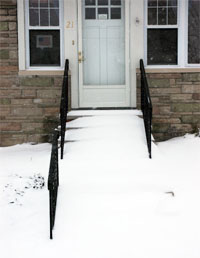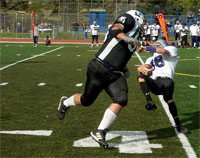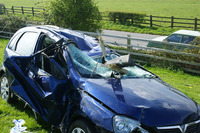Posts Tagged ‘Boston’
Property Owners Are Responsible for Clearing Snow and Ice
 With snow in the forecast, now is the time to dig out your shovel. Clearing snow from your property has always been the right thing to do, but it is now also a requirement under Massachusetts law.
With snow in the forecast, now is the time to dig out your shovel. Clearing snow from your property has always been the right thing to do, but it is now also a requirement under Massachusetts law.
With the case of Papadopoulos v. Target Corporation, in July 2010 the Supreme Judicial Court abolished the long-standing legal distinction between natural and unnatural accumulations of snow and ice. Property owners are now required to clear both types of snow fall and may be held liable if there is a snow and ice injury on their property.
Here are a few tips from our Boston personal injury lawyers:
Remember to salt. Salt your driveway early in the storm and regularly.
Know how to use your snow blower. Turn it on before the snow fall and read the instructions. In between storms, keep it covered or in a garage.
Remember everyone who travels. You are responsible for clearing driveways, paths and all areas which can be reasonably accessed by invited guests as well as passersby and mail carriers.
Watch for tree branches. If tree branches fall on your property during the snow, consider making cuts before the next storm so no one is hurt.
Hire a snow plow. During heavy snow storms, consider hiring a snow plow.
Clear areas for emergency professionals. Help dig out fire hydrants and storm drains in your neighborhood.
Call about downed wires immediately. If you come across a downed power line, call your police department and ask them to call the utility company. Never attempt to clear the snow around it.
Stay off the streets. In the early hours of a snow storm, pedestrians can interfere with municipal plows.
Read More
Medical Device Recall: Stryker Rejuvenate and ABG II Hip Implants
The year 2012 saw another major hip replacement recall which may require an intensive treatment plan for patients.
In July 2012, Stryker recalled two hip replacements, the Rejuvenate and ABG II modular-neck stems. Stryker initiated the voluntary recall due to the potential risks for fretting and corrosion at the junction of the metal stem and metal neck.
Several months later, product liability lawsuits have been filed in a few states and patients are still learning what the recall may mean for them. The recall came two years after DePuy Orthopedics recalled its all-metal hip implant, the ASR XL Acetabular System, in 2010. A study showed the DePuy hip implant failed in one of eight patients and required they undergo a second surgery within five years – compared to the industry standard of 15.
The DePuy hip implant caused friction between the metallic ball and socket components and injuries such as bone fractures, trouble walking and metallosis, a painful condition which occurs when metallic particles appear in a patient’s blood stream.
With the Stryker recall, the company states the incidence of complications is extremely low and that patients who experience pain and swelling should speak with their surgeon. If a patient does require a second surgery, it may be more complex than in the DePuy recall. The neck stem of Stryker’s hip implant was implanted tightly into the femur bone to stay permanently. There may be potential for complications such as bone fractures.
If you have a Stryker hip implant, you should have been contacted by your surgeon about the recall. If not, you should contact them now as well as an experienced medical device lawyer, who can represent your interests.
Contact an Experienced Hip Implant Recall Lawyer The Boston product liability lawyers at Breakstone, White & Gluck have over 100 years combined experience handling cases involving defective medical devices and pharmaceuticals. If you have been injured, it is important to learn your rights. For a free legal consultation, contact us today toll-free at 800-379-1244 or 617-723-7676 or use our contact form.
Related: Stryker Initiates Voluntary Product Recall of Modular-Neck Stems, Food and Drug Administration.
What to Know About Medical Device Recalls
Medical devices are supposed to improve the quality of a patient’s health. When they are surgically implanted, patients expect an extensive recovery and regular medical check-ups. But no patient should expect the medical device to cause new injuries or to be recalled.
Medical devices are supposed to undergo a rigorous approval process with the Food and Drug Administration (FDA) before going on the market, but some screening fails to identify defective devices. Here are some things every patient using a medical device should be aware of regarding product recalls.
Who is Responsible for a Medical Device Recall? The FDA can legally require a company to recall a medical device. In many cases, however, companies recall their own medical devices.
What Does a Recall Mean? A medical device is recalled when it no longer meets FDA requirements. A recall means a medical device is defective, poses a risk to a person’s health, or both.
A recall may mean the device needs to be removed and replaced. It may also mean the device needs repairs or monitoring.
There are three classes of medical device recalls. A Class I Recall is the most serious and indicates there is a reasonable chance the recalled medical device could cause serious illness or even death.
A Class II Recall means a product may cause temporary health problems. A Class III Recall is the least serious type and occurs when the FDA instructs a manufacturer to make a correction that violates FDA regulations.
What is the 510(k) Approval Process? The FDA approves 90 percent of medical devices under the 510(k) process, including many devices which have been recalled in recent years. These include hip implants, external heart defibrillators and transvaginal mesh.
The process – also called Premarket Notification – was designed to bring new treatments to patients faster. Manufacturers must notify the FDA of their intent to market a medical device at least 90 days in advance. Medical device manufacturers are required to submit premarket notification if they plan to introduce a device for the first time or reintroduce a device that will be significantly changed or modified to the extent that its safety could be affected.
How to Learn About a Medical Device Recall. Your doctor or the medical device manufacturer should notify you. You can visit the manufacturer’s website to check for recall notices. The FDA also maintains an online medical recall database. Finally, large medical device recalls may receive media coverage, which may answer some of your questions.
What to Do When a Medical Device Recall Occurs. You can expect to work with the manufacturer as well as your doctor or surgeon.
You should follow your doctor’s advice, except if he or she asks you to sign a form authorizing the release of your medical records before treatment is undertaken. This would allow your physician to release your medical records directly to the manufacturer. It is not in your best interest to sign the release before speaking to an attorney.
Contact a Boston Medical Device Recall Lawyer. If you have a medical device which has caused you injury – or which you suspect has caused you pain and injury – you should contact an experienced Boston product liability lawyer. You may be entitled to file a lawsuit to recover damages for pain and suffering, medical costs and other expenses. You may also be entitled to damages if a loved one has suffered illness or been killed as a result of a defective medical device.
Medical device recalls are debilitating for patients who have often already suffered physical pain. Recall lawsuits are complex. If you have been injured by a defective medical device, Breakstone, White & Gluck has the experience, expertise and resources to obtain you results in your claim.
For a free legal consultation, contact us today toll-free at 800-379-1244 or 617-723-7676 or use our contact form.
Product Liability: Infant Recliner Recall Sought After 5 Deaths
 A manufacturer of baby recliners involved in five infant deaths is now the target of a lawsuit filed by the Consumer Product Safety Commission (CPSC).
A manufacturer of baby recliners involved in five infant deaths is now the target of a lawsuit filed by the Consumer Product Safety Commission (CPSC).
The CPSC filed a complaint against Baby Matters, LLC of Berwyn, Pennsylvania on Dec. 5 after the company refused to issue a voluntary recall of the Nap Nanny Generation One and Two and Chill models. The CPSC is aware of four infants who have died in Nap Nanny Generation Two recliners and one in a Chill model. It has received over 70 additional reports of children nearly falling out of the defective product.
The CPSC complaint alleges the company’s recliners contain defects in design, warnings and instructions, which pose a substantial risk of injury and death to infants. It seeks an order requiring the firm notify the public of the defect, remove it from store shelves and offer consumers a full refund. The company’s website and media reports state it has gone out of business as a result of its legal costs.
Some 155,000 of the recliners have been sold since 2009. The company sold 5,000 Nap Nanny Generation One models and 50,000 Nap Nanny Generation Two models between 2009 and early 2012. Both are now discontinued. A recall was issued in July 2010 announcing Generation One owners would receive an $80 coupon and improved instructions and warnings to consumers who owned the Generation Two Nap Nanny recliner.
The company developed the Nanny Chill model as an improvement. One hundred thousand Nap Nanny Chill models have been sold since January 2011. The recliners are priced about $130.
The 2010 recall came after the CPSC learned about one death that occurred in a Nap Nanny recliner and received 22 reports of infants hanging or falling out over the side, even though most had been harnessed in.
In a statement on the company’s website, owner/founder Leslie Gudel, said, “We do not believe the complaint has merit and stand behind the safety of our product when used as instructed.”
Later in the statement, she said, “No infant using the Nap Nanny properly has ever suffered an injury requiring medical attention. The Nap Nanny was designed and constructed for use only on the floor with the harness secured.”
Related:
Five infant deaths Prompt CPSC to Sue Manufacturer of Nap Nanny and Chill Infant Recliners, Consumer Product Safety Commission.
A message from Leslie Gudel – owner/founder Nap Nanny
Feds file suit against Nap Nanny maker after 5 infant deaths, 70 complaints, ABC News.
Read More
Head Injuries: Boston University Study Investigates Brain Damage in Deceased Athletes
 In a new study, Boston University School of Medicine researchers autopsied the brains of deceased athletes who suffered repeated concussions and found the majority showed signs of a degenerative brain disorder called chronic traumatic encephalopathy (CTE).
In a new study, Boston University School of Medicine researchers autopsied the brains of deceased athletes who suffered repeated concussions and found the majority showed signs of a degenerative brain disorder called chronic traumatic encephalopathy (CTE).
The researchers autopsied 85 deceased brain donors, including 82 athletes. This included 34 professional football players. Researchers found a buildup of an abnormal brain protein called tau in 68 brain donors. By contrast, they autopsied 18 brains with no known trauma and found no protein buildup. Tau is associated with CTE, a degenerative condition linked to memory loss, depression and dementia.
The autopsies found the most extensive brain damage in the professional athletes who died after age 50. They experienced the most severe memory loss and personality changes in their final years.
The football players included National Football League (NFL) Hall of Famers running back Ollie Matson and Colts tight end John Mackey. Both died last year after suffering from dementia.
The researchers also described the four stages of CTE. In the first stage, the injured individual experiences headaches and trouble concentrating. Symptoms progress to depression, aggression and short-term memory loss, followed by serious cognitive impairment and dementia.
Last spring, more than 3,000 former players filed a lawsuit against the National Football League, claiming the league hid information about football-related head injuries. The NFL claims the head injury lawsuits have no merit and asked a federal court in Philadelphia to dismiss more than 100 injury claims, saying they should be resolved through the NFL’s collective bargaining process rather than the courts.
Many states, including Massachusetts, have also implemented laws in recent years which mandate concussion training for high school athletes and provide rules for how long students must sit out after a head injury.
The research was reported in the journal Brain.
Related:
Boston researcers find new evidence linking concussions to permanent brain injury, The Boston Globe.
Evidence of brain damage from repeat concussions mounts, The Boston Globe.
NFL asks federal judge to dismiss concussion lawsuits, NFL.com.
BU-Led Research Maps the Route to Dementia, BU Today. Read More
Gas Explosion: Springfield Recovers as State Investigation Begins
State Fire Marshal Stephen Coan said human error is to blame for the massive gas explosion in Springfield which injured 21 people, damaged three dozen buildings and leveled a night club.
The explosion at Scores Gentlemen’s Club on Worthington Street ignited Friday after Columbia Gas of Massachusetts sent crews to investigate a report of a gas odor. One worker accidentally punctured a gas line at the foundation of the building with a metal probing tool. The company said there were older gas line markings on the nearby sidewalk which were incorrect.
State and local officials held a press conference Sunday and announced Columbia Gas had performed a block-by-block investigation of the area and determined the city’s gas systems are now safe and functioning.
Coan said they have determined the source of the fuel and activities which led to the gas explosion. He said the state Department of Public Utilities will continue the investigation into Columbia Gas related to their response to the incident.
Coan said investigators have not determined the source of the initial odor and may not be able to now that the building is no longer standing. But he said there was no leak of gas from the main in the street.
“We have determined that human error, as opposed to a fault in the gas infrastructure, is what the cause of the explosion was,” he said.
He also said there were too many possible ignition sources inside the multi-story building to identify what had triggered the gas explosion.
Those sent to the hospital include 12 of the 14 Springfield firefighters who initially responded. All have been released. News reports say others injured include gas workers, a water and sewer worker and a local TV cameraman.
Today, residents and business owners gathered at Springfield City Hall carrying lists of lost personal belongings and damaged property. Columbia Gas has promised to cover the expenses, city officials say.
Related:
Springfield explosion cause: ‘Human error,’ Massachusetts fire marshal says, The Republican.
Raw Video: Springfield Gas Explosion, The Boston Globe.
Read More
Gas Explosions: More than 3,300 Gas Leaks in Boston
 There are more than 3,300 natural gas leaks in Boston’s aging underground pipelines, a new Boston University study has found. Six areas had gas levels which exceeded the amount needed to trigger a gas explosion.
There are more than 3,300 natural gas leaks in Boston’s aging underground pipelines, a new Boston University study has found. Six areas had gas levels which exceeded the amount needed to trigger a gas explosion.
Those gas leaks were repaired while no action has been taken on the others, which the state Department of Public Utilities and gas companies described as a small risk for gas explosions. Dorchester had the largest number of gas leaks, 951 breaks over 158 miles of cast-iron gas mains. However, several areas had a greater number of leaks per mile, including East Boston, Jamaica Plain, Brighton, Charlestown and South Boston.
The study into gas leaks and explosion risks was conducted by an associated professor from Boston University’s Department of Earth and Environment and a researcher from Duke University. It was recently published in the journal Environmental Pollution and reported on by the Boston Globe.
The two researchers drove all 785 miles of Boston’s streets to test the air for methane, the primary ingredient in natural gas. The two measured for methane levels which exceeded 2 parts per million – the normal amount in the air.
Natural gas is colorless and odorless, but uses the chemical additive mercaptan which emits a distinct rotten eggs odor to signal a leak. Gas leaks can occur in several ways, often when underground pipes crack as they age or in cold weather or when a pipe is struck by construction equipment.
Some people want to hold gas companies more accountable for fixing gas leaks in Massachusetts. A bill sponsored by state Representative Lori Ehrlich of Marlbehead would require a timeline for fixing the most serious leaks. Utilities would be required to notify police and fire of the gas leak locations. The bill unanimously passed the House of Representatives in June and is now before the state Senate.
The Conservation Law Foundation plans to release a report on natural gas leaks soon. An official suggested the state could require timelines for gas companies to repair various grades of leaks and improve accelerated reimbursement rates for gas companies that replace old gas lines.
Related:
- Boston riddled with mostly small natural gas leaks, Boston University study finds, Boston Globe.
- Gas leaks graphic, Boston Globe.
- Breakstone, White & Gluck settles wrongful death lawsuit for explosion’s victim’s family for $7.5 million, July 2012.
Toy Safety: 10 Worst List Highlights Dangerous Toys
 As the holiday shopping season begins, a watchdog organization is reminding consumers that not every toy on the shelves is safe.
As the holiday shopping season begins, a watchdog organization is reminding consumers that not every toy on the shelves is safe.
The organization W.A.T.C.H., or World Against Toys Causing Harm, Inc., has released its annual list of 2012 “10 Worst Toys.” W.A.T.C.H. says the toys on the list can cause children to choke, have sharp parts and carry misleading labels. The defective toys can be found online and in stores, at major retailers such as Toys “R” Us, Walmart and Amazon.
Dangerous toys seriously injure and kill children every year in the United States. In 2010, 17 children were killed in toy-related accidents. The majority were related to choking on balloons, small balls and rubber balls. The same year, about 181,500 children younger than 15 were treated in hospital emergency departments for toy-related injuries.
If you are shopping for young children, take a look at this year’s “10 Worst Toys” list. We have also provided a list of websites to help you make safe purchases below.
The Avengers Gamma Green Smash Fists
Potential for blunt impact injuries and there are no warnings on the package.
Playful Xylophone
Potential for choking injuries.
Power Rangers Super Samurai Shogun Helmet
Potential for impact and puncture wound injuries.
Water Balloon Launcher
Potential for choking and facial injuries. Varying age recommendations online and on the package.
N-Force Vendetta Double Sword
Potential for Impact injuries.
Explore & Learn Helicopter
Potential for strangulation and entanglement injuries. Cord is twice the length allowed by law.
Spinner Shark 4-Wheel Kneeboard
Potential for impact injuries.
Dart Zone Quick Fire 12 Dart Gun
Potential for eye injuries.
Bongo Ball
Potential for impact and other serious injuries. Children are encouraged to climb inside the inflatable ball. The toy and the packaging have contradicting instructions about supervision.
Magnetic Fishing Game
Potential for choking injuries. Different age recommendations online and on the packaging.
Related:
Toy Safety Fact Sheet, Safe Kids.
Toy Safety, U.S. PIRG.
Dangerous Toy Report Details Lead, Choking Hazards, Breakstone, White & Gluck.
Preventing Cooking Accidents This Thanksgiving
 Thanksgiving dinner is the largest meal of the year for many families, the one that takes the most planning and time to prepare. As you work in the kitchen, remember Thanksgiving is also the nation’s leading day for kitchen fires and when burns and cooking injuries are more likely to occur. The good news is you can prevent most of these accidents and focus on enjoying the day by following a few simple steps below. We have also included safety precautions for deep frying a turkey.
Thanksgiving dinner is the largest meal of the year for many families, the one that takes the most planning and time to prepare. As you work in the kitchen, remember Thanksgiving is also the nation’s leading day for kitchen fires and when burns and cooking injuries are more likely to occur. The good news is you can prevent most of these accidents and focus on enjoying the day by following a few simple steps below. We have also included safety precautions for deep frying a turkey.
Make sure your smoke detector is working. Test it in advance and do not disable it.
Use a cooking timer. This will help you keep track of when to check the turkey and when other food dishes are finished.
Stay home while cooking. Stay home and check the turkey frequently.
Cooking stovetop. Stay in the kitchen when you are cooking stovetop. If you must leave, turn the stove off.
Keep children away. Keep children at least three feet away from the stove at all times.
Hot food and liquids. Make sure children also stay away from hot food and liquids, which can cause burn injuries. This includes coffee, gravy and the steam and sauce on vegetables – especially when they first come out of the oven or off the stove.
Neat kitchen. Keep clutter to a minimum near the stove. Set aside oven mitts, towels and other utensils. Do not leave sharp knives or utensils out where young children can reach them. Ask guests to put their belongings in another area.
Keep matches, lighters and candles away. Lock matches and utility lighters in cabinets away from children. Also do not use candles if you have young children in the home.
Use a commercial cooking bag. Do not cook your turkey in a brown paper bag from the grocery store. They are unsanitary and may start a fire.
Tips if you are deep frying your turkey:
Read the instructions. Read the manufacturer’s instructions for the turkey fryer before each use.
Understand your propane gas burner. Ask your propane gas provider about safe practices to prevent fires and explosions.
Wear safety gear. Wear safety glasses, gloves which stretch to your elbows, a long-sleeved shirt and an apron.
Deep fry your turkey outside. Set up your fryer in an open area, away from your house, garage, decks and other structures.
Select a smaller turkey. Use a turkey that is 12 pounds or less in size.
Do not stuff the turkey. Stuffing the turkey could interfere with even cooking.
Do not use too much oil. Determine the right amount of oil in advance by placing the turkey in the fryer. Fill with water to the top. Remove the turkey and measure the amount of water remaining. Use the same amount of oil. Your fryer may also have a measurement line inside.
Fully thaw the turkey. Burn injuries can occur when any water on the turkey comes in contact with the oil, then boils over or splatters while being cooked. Fully thaw the turkey and dry it off with paper towels before deep frying.
Turn off the fryer before adding the turkey. Warm up the fryer before cooking, then turn it off just before putting the turkey inside. Start cooking again after it is firmly in place.
Related:
Thanksgiving Safety, National Fire Protection Association.
Cooking Safety, National Fire Protection Association.
Read More
Drowsy Driving Accidents Are Preventable
 Younger drivers are the most likely to drive drowsy, with one out of seven drivers ages 16-24 admitting to nodding off behind the wheel at least once in the past year, a National Sleep Foundation study found.
Younger drivers are the most likely to drive drowsy, with one out of seven drivers ages 16-24 admitting to nodding off behind the wheel at least once in the past year, a National Sleep Foundation study found.
The National Sleep Foundation released its study for its annual campaign, Drowsy Driving Prevention Week, from Nov. 12-18. The foundation’s study also found one in 10 of all licensed drivers admitted to falling asleep during the past 12 months. The AAA Foundation for Traffic Safety estimates that about one in six deadly car crashes involves a drowsy driver. In addition to drivers who are falling asleep, the National Sleep Foundation’s 2011 Sleep in America poll found that among those who drove, 52 percent indicated they have driven drowsy and 37 percent had done so in the past month.
Across the country, four states have laws related to drowsy driving: New Jersey, California, Utah and Florida.
The laws vary, providing for a mix of educational campaigns, research and in New Jersey, a law criminalizing drowsy driving. Maggie’s Law states a drowsy driver – one who has not slept in 24 hours – qualifies as a reckless driver who can be convicted of vehicular homicide. The law was passed in 2002 following a car accident which claimed the life of 20-year-old college student Maggie McDonnell. The student was struck by a driver who had not slept for 30 hours and had been using drugs.
The jury deadlocked in the first trial involving the fatal car crash. During the second trial, the defense lawyers argued that there was no law against falling sleep behind the wheel in New Jersey so the driver did nothing wrong. The driver received a suspended jail sentence and $200 fine.
In Massachusetts, Sen. Richard T. Moore, (D-Uxbridge) has proposed “Rob’s Law,” which was placed under a study order this summer. The legislation is named for Major. Robert Raneri of the United States Army Reserve, who was killed in 2002 by an admitted drowsy driver on his way to work at Fort Devens.
The bill would make it a criminal offense for drivers to drive drowsy in Massachusetts. In cases where drivers cause a car accident resulting in death, they could be charged with homicide by a motor vehicle while under the influence of an intoxicating substance.
Drowsy driving car accidents can be prevented through awareness and good decisions. Our Boston car accident attorneys offer this list of signs which should serve as warnings not to drive:
- Difficulty focusing, frequent blinking and heavy eyelids.
- Driving mistakes such as drifting from your lane and swerving.
- Not seeing other cars until they are immediately near you.
- Daydreaming.
- Trouble keeping your head up.
- Disobeying traffic lights or failure to see them change until another driver honks.
- Missing traffic exits.
- Not remembering traveling the last few miles.
- Yawning.
- Restlessness, irritability or aggression.
Other steps to avoid drowsy driving and car accidents:
- Get a good night’s sleep of seven to nine hours at night.
- Do not be in a rush to arrive at your destination.
- Avoid driving long distances alone when you can.
- Avoid alcohol and medications that cause drowsiness.
- Consume caffeine if you need it.
- Avoid driving at times you are normally asleep.
- For long distance travel, take a break every 100 miles or 2 hours. Get a snack, change drivers, take a walk.
- Make sure you eat regular meals and snacks.
- If you need, stop and find a safe place to nap.
- Avoid alcohol and medications that cause drowsiness.
Related:
Bill S.1773: An Act relative to drowsy driving.
Drowsy Driving, National Sleep Foundation.
Read More

